Contents
Page Design
|
Introduction Graphic design 100 Balanced pages Design grids for pages Page headers Typography I Typography II Typefaces Consistency Basic Tables Page length Cross platform issues Editorial style Frames Advanced tables Style sheets Miscellaneous |
Web page design is largely a matter of balancing the power of hypermedia Internet linkages against the ability to imbed graphics and motion media within networked Web pages. Some home or menu pages function more like the covers of books or magazines. The idea is to draw the user into the material with a combination of text descriptions and interesting graphics related to the subjects:
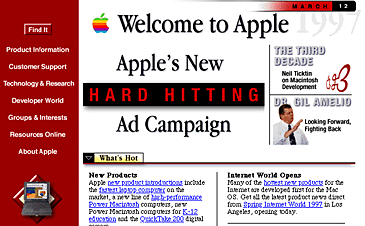
Graphic has been reduced from the original size. www.apple.com
The most efficient designs for general (mostly modem-based) Internet audiences tend to use careful layouts of text and links with relatively small graphics. These pages load into viewers quickly, even when accessed from 28.8 kbps modems over SLIP or PPP lines, yet these pages still achieve a substantial graphic impact. This is razorfish's elegant but minimal layout design for the Pace-Wildenstein Gallery:
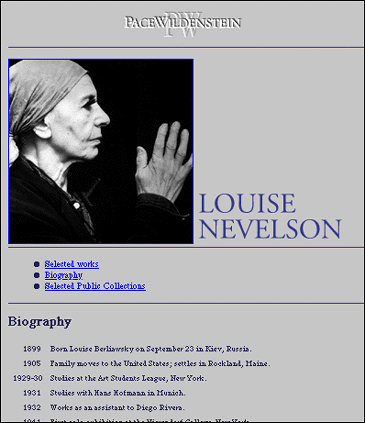
Graphic has been reduced from the original size. http://www.pacewildenstein.com/
The screen is smaller than a printed page
While Web pages and conventional documents share many graphic, functional, and editorial similarities, the computer screen is the primary delivery site for web-based information, and the computer screen is very unlike the printed page. Graphic designers often create page grids that look great on their extra-large monitors, forgetting that most users cannot display more than about half of the typical Web page at any one time, and only 10% of Web surfers ever scroll the page.
Width of page graphics
Computer screens are typically smaller than most books or magazines. A very common mistake in Web design is spreading the horizontal width of your page graphics beyond the area most viewers can fit on their 14-15 inches display screens.
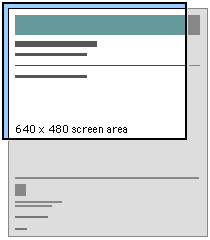
Graphic dimensions for web pages
Web page graphics should not be more than 535 pixels wide or more than about 320 pixels high, or the graphic will be too wide to print on letter size or A4 paper. Even when your readers have large display screens, the typical Netscape or Internet Explorer window still defaults to a window width designed for smaller monitors. Microsoft's otherwise excellent home page is too wide for many standard office monitors:
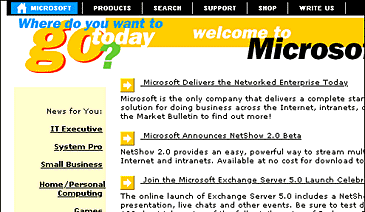
Graphic has been reduced from the original size. www.microsoft.com
The following size recommendations are based on the typical dimension of a Web browser on a 14 inch or 15 inch Macintosh or Windows 95 screen:
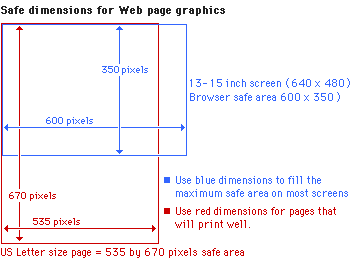
Design grids for HTML pages
A Web page can be almost any length, but you've only got about 30 square inches at the top of your Web pages to capture the average reader, because that is all they will see as your page loads. If all you offer is a big, slow-to-load graphic, many casual readers will leave before they ever see the rest of your Web site.
Page with grid background
This page shows the same background graphic placed on the page, where you can copy it for your own use. Follow the procedures for your particular browser in copying images. Users of the Windows version of Netscape should click on the graphic with the right mouse button to get a menu of options for copying and saving the graphic. Mac users of Netscape 2.0 or later should click and hold down the mouse button until the pop-up menu appears.
Clown's pants
Current implementations of the Hypertext Markup Language (HTML) do not allow the flexibility or control that graphic designers routinely expect from page layout software or conventional multimedia authoring tools. However, the HTML markup language can be used to create complex and highly functional information systems if it is used carefully. When used inappropriately or inconsistently the typographic controls and inlined graphics of World Wide Web (Web) pages may result in a patchy, confusing jumble, without any apparent visual hierarchy of importance. This unfortunate "clown's pants" effect of haphazardly mixed graphics and text results in decreased usability and legibility, just as it does in paper pages. A carefully organized design grid that is consistently implemented across a range of pages will aid your users in quickly finding the information they want, and will increase the reader's confidence that they are using a thoughtfully organized collection of information:
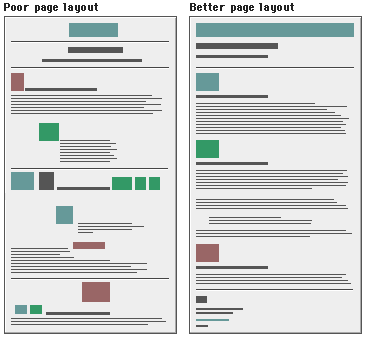
Apple Computer, Inc. Hurlbutt, A. 1978. The grid. New York: Watson-Guptill. Microsoft Corporation Pace-Wildenstein Gallery razorfish White, J. V. 1988. Graphic design for the electronic age. New York: Watson-Guptill. |